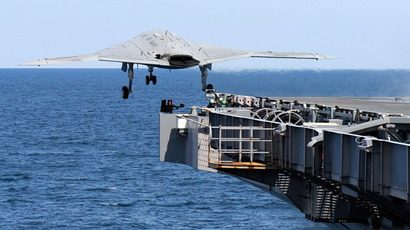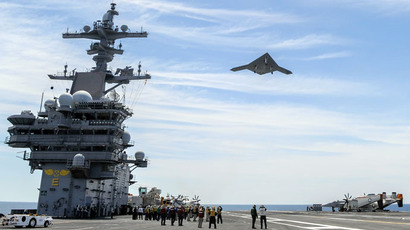Unmanned drone makes first landing on US Navy aircraft carrier (VIDEO)
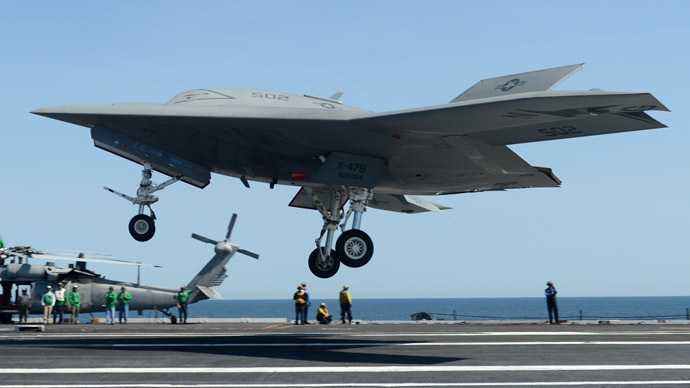
The experimental X-47B drone has successfully landed on a US Navy aircraft carrier for the first time since its May launch. This means the US can now launch drones overseas without needing to use bases in other countries.
The unmanned X-47B aircraft, which is a prototype drone the
size of a fighter jet developed by the American defense
technology company Northrop Grumman, took off from a naval air
station in Maryland on Wednesday. The drone then landed on the
USS George H.W. Bush off the coast of Virginia.
The drone successfully performed a maneuver known as “arrested
landing,” which involved catching a wire on board the ship with a
deployed tail hook, bringing the aircraft to a quick stop.
The task is considered to be one of the most challenging for a
human pilot, due to constant movement of the ship and the
turbulent air around it. The procedure was performed exclusively
by the drone’s built-in computer program.
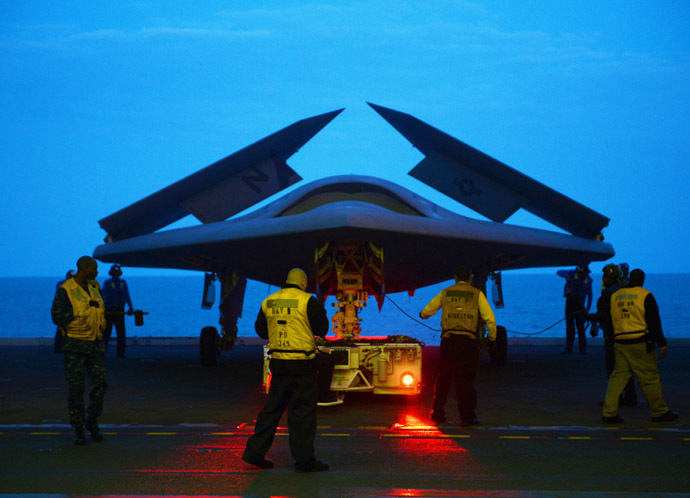
If the drone ever fails to catch the wire, it is said to be able
to perform a touch-and-go stunt to try to land again. The X-47B
made nine such maneuvers in May, when it was successfully
catapulted from an aircraft carrier for the first time.
The US navy saluted the drone’s test, with Rear Admiral Mat
Winter calling it “historic event” worth mentioning in
“history books.” However, the drone’s capabilities have
raised concerns over possible expansion of Washington’s
controversial overseas drone program.
The successful launch of the drone prototype would likely prompt
the Navy to go ahead with its plans to order a fleet of
carrier-based drones. According to Winter – the US Navy’s program
executive officer for unmanned aviation and strike weapons – such
drones could begin operating by 2020.
According to the US Navy, Wednesday’s maneuver marks the first
instance of a tailless, unmanned drone landing on a modern
aircraft carrier. The demonstration was the final of three at-sea
test periods for the X-47B drone, all of which took place in the
past eight months.
The unmanned drone spent several weeks aboard various aircraft
carriers in previous months. The US Navy completed deck
operations aboard the USS Harry S. Truman in December 2012, and
aboard the USS George H.W. Bush in May.
"We have been using the same
[carrier] landing technology for more than 50 years now and the
idea that we can take a large UAV and operate in that environment
is fascinating," said Capt. Jaime Engdahl, Navy UCAS
program manager.
It also means the US would soon be capable of launching drone
missions overseas without the need to obtain permission to use
other countries’ ground bases. Such missions could vary from
around-the-clock surveillance to targeted strikes, as the $1.4
billion X-47B is said to be able to carry missiles.
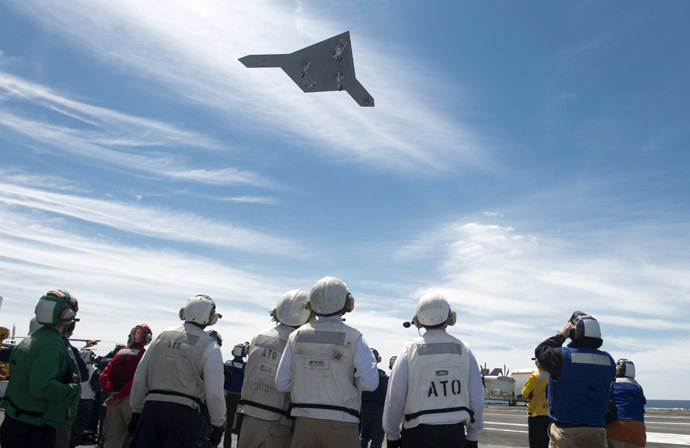
According to the Navy, new generation drones would be at least three times the range of the notorious Predators, while having the capability to carry out programmed missions without human intervention. They would rely on advanced flight control software and precision GPS navigation, but retain the option of a remote control by a human operator when needed.
Northrop Grumman X-47B
Max speed: ~Mach 0.9 (~685 mph, ~1,100 km/h)
Service ceiling: 40,000ft (12,000 m)
Length: 38.2 ft (11.63 m)
Range: >2,100 nmi (>3,889 km)
Wingspan: 62.1 ft (18.92 m)
Weight: 14,000 lb (6,350 kg)
General Atomics MQ-1 Predator
Max speed: 135 mph (217 km/h)
Service ceiling: 25,000 ft (7,620 m)
Length: 27 ft (8.22 m)
Range: 675 nmi (1,100 km)
Wingspan: 48.7 ft (14.8 m)
Weight: 1,130 lb (512 kg)
The prototype X-47B can already boast reaching an altitude of
12km, and is said to be able to travel in a range of about
4000km. The US Navy plans to demonstrate that the drone can be
refueled in flight, which would increase its range even further.
The new drone and the research around it have already come under
criticism amid concerns that deadly attacks could get out of hand
without a pilot to control the aircraft.
Human Rights Watch has particularly protested the development of
drones that carry weapons and are fully autonomous.
“We’re saying you need to draw the line when you have a fully
autonomous system that is weaponized. We’re saying you must have
meaningful human control over key battlefield decisions of who
lives and who dies. That should not be left up to the weapons
system itself,” Steve Goose, director of the arms division at
Human Rights Watch, said in a statement.
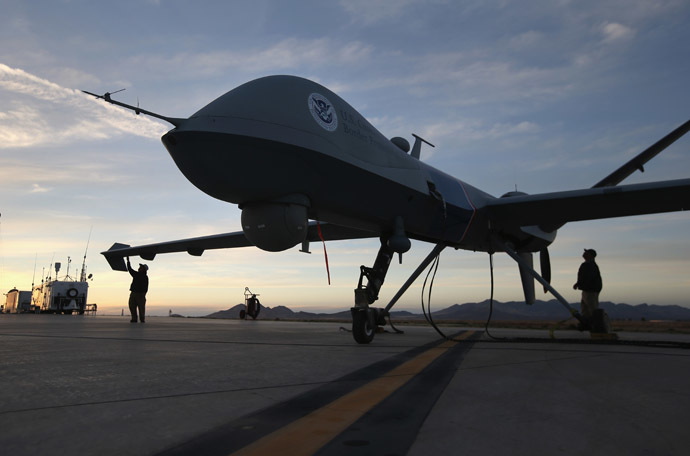
The UN Human Rights Commission has published a report calling for
a worldwide moratorium on the “testing, production, assembly,
transfer, acquisition, deployment and use” of autonomous
weapons systems until an international conference can develop
rules for their use. The systems, which are referred to as
“lethal autonomous robotics” (LARs) in the report,
“should not have the power of life and death over human
beings,” said Christof Heyns, the UN’s Special Rapporteur on
Extrajudicial, Summary or Arbitrary Executions.
Washington’s use of Reaper and Predator drones in targeted
strikes in Iraq, Afghanistan, Pakistan, and Yemen has been a
subject of international criticism amid reports of widespread
civilian casualties. Both US and foreign critics have said that
the controversial drone program is conducted with inadequate
oversight.
In May, President Obama announced plans to scale back drone strikes in foreign lands, only deploying the unmanned aircraft when a threat was “continuing and imminent.”
But UN special rapporteur on counterterrorism and human rights, Ben Emmerson, said that any justification cited in international law by US officials for the use of lethal drone strikes is not accepted outside the United States. Emmerson, who has been investigating the US drone program since January, also said that the American monopoly on unmanned aircraft technology is “over,” and the US should engage in “a dialogue” on the international legal framework surrounding the use of drones.













